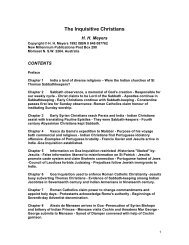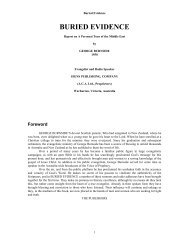Battle of the Bibles - Present Truth
Battle of the Bibles - Present Truth
Battle of the Bibles - Present Truth
You also want an ePaper? Increase the reach of your titles
YUMPU automatically turns print PDFs into web optimized ePapers that Google loves.
BATTLE OF THE BIBLES 2E<br />
Chapter Twenty-Seven<br />
Fruits <strong>of</strong> Anti Christ<br />
The story <strong>of</strong> <strong>the</strong> <strong>Battle</strong> <strong>of</strong> <strong>the</strong> <strong>Bibles</strong> would remain little more than one <strong>of</strong> historical<br />
interest unless its relevance to present day Christianity can be demonstrated. There are<br />
those who love to assure us that textual variations have little or no bearing on basic<br />
Christian doctrine. If this be so, <strong>the</strong>n we can only conclude that <strong>the</strong> leading contenders<br />
for <strong>the</strong> revision <strong>of</strong> <strong>the</strong> King James Version failed miserably in <strong>the</strong>ir expectations; for <strong>the</strong><br />
leading agitator for revision, who also became chairman <strong>of</strong> <strong>the</strong> New Testament<br />
Committee <strong>of</strong> Revision, made no secret <strong>of</strong> his desire for change, meaning doctrinal<br />
change. Said Bishop Ellicott:<br />
"Here our duty is obvious. Faithfulness and loyalty to God's truth, require that <strong>the</strong><br />
correction should be made unhesitatingly" (Ellicott, "Considerations", p 88).<br />
Accordingly, we shall here <strong>of</strong>fer some comparisons <strong>of</strong> texts from five Bible<br />
versions "against" that <strong>of</strong> <strong>the</strong> King James Version. In <strong>the</strong> process, it will be noticed that<br />
Ellicott's expectations have been realised - not only in <strong>the</strong> Revised Version, but<br />
progressively more so in subsequent versions.<br />
The five versions chosen are representative <strong>of</strong> changes in translations<br />
approximating <strong>the</strong> period between <strong>the</strong> publication <strong>of</strong> <strong>the</strong> Douay and Jerusalem Versions,<br />
both <strong>of</strong> which are Roman Catholic <strong>Bibles</strong>. This is <strong>the</strong> period covering roughly <strong>the</strong> era <strong>of</strong><br />
<strong>the</strong> development <strong>of</strong> Protestantism until its virtual demise following Vatican II Council<br />
(1962 to 1965). The reader may compare o<strong>the</strong>r versions with this fairly representative<br />
selection.<br />
The versions selected for this exercise <strong>of</strong> comparison with <strong>the</strong> KJ V are:<br />
1. The Douay Version (1914 Edition) published and revised from <strong>the</strong> Rheims<br />
(1582) and <strong>the</strong> Douay (1609) version.<br />
2. The Revised Version (RV 1897).<br />
3. The Revised Standard Version (RSV published by Thomas Nelson 1957).<br />
4. The Jerusalem Bible (JB 1971).<br />
5. The New International Version (NIV 1978).<br />
It is here pertinent to note some ways in which attacks on Scripture are launched.<br />
By injecting seeds <strong>of</strong> doubt by means <strong>of</strong> marginal or foot notes; by changes which effect<br />
<strong>the</strong> meaning ei<strong>the</strong>r subtly or by outright contradictions; or by omission <strong>of</strong> words, phrases,<br />
sentences and whole verses.<br />
We shall group <strong>the</strong>se attacks on <strong>the</strong> Received Text under broad doctrinal<br />
headings and list <strong>the</strong> Scriptural comparisons in <strong>the</strong> order in which <strong>the</strong>y appear in <strong>the</strong><br />
Bible. This is by no means an attempt at a detailed analysis, but it will be sufficient to<br />
demonstrate that important doctrines are effected. When any <strong>of</strong> <strong>the</strong>se five versions do<br />
not appear in our analysis, it is because it is in thought-agreement with <strong>the</strong> KJV.<br />
The doctrines with which we will be here concerned are:<br />
1. Messianic Prophecies.<br />
2. Christ's divinity and Creatorship.<br />
1





